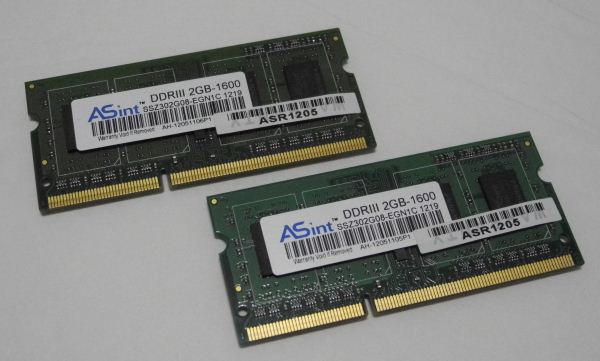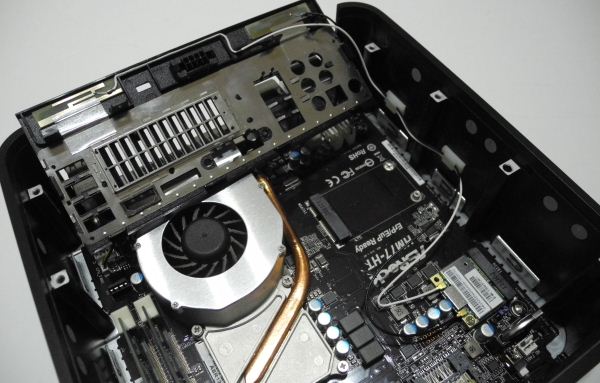ASRock Vision HT: Ivy Bridge Carries the SFF HTPC Forward
by Ganesh T S on November 12, 2012 3:30 PM EST- Posted in
- Home Theater
- ASRock
- HTPC
- Ivy Bridge
System Teardown and Analysis
The ASRock Vision HT 321B is primarily built out of notebook components, and it is quite difficult for the average enthusiast to build such a system with off-the-shelf components.
Motherboard & Chipset : mini-ITX Intel HM77
The motherboard used in the CoreHT series is based on the Panther Point Intel HM77 chipset. There are three SATA headers on the motherboard, with one connected to the hard drive, one to the optical drive and another left unconnected for a second 2.5” drive. The unit also has a mSATA slot. In addition, we also have an eSATA2 port on the rear side of the chassis.
The motherboard exposes four PCIe 2.0 x1 lanes, of which one is connected to the Atheros 9462 WLAN / Bluetooth solution, and the other is connected to the Realtek 8168 GbE controller. As seen in previous ASRock HTPCs, the two sides of the chassis are used as antennae. The two DIMM slots are on the right side of the board, next to the CPU.
CPU : Intel Core i5-3210M
The Core i5-3210M is a 35W TDP processor belonging to the 22nm Intel Ivy Bridge family. Clocking in at 2.50 GHz, it is capable of going up to 3.1 GHz in Turbo mode. The instruction and data caches are 32K each, with a 256 KB common L2 cache. For L3, we have 3MB of Intel Smart Cache shared between the two cores and the integrated GPU.
GPU : Intel HD Graphics 4000
The integrated GPU in the Ivy Bridge processors come in two varieties, namely, HD Graphics 2500 and HD Graphics 4000. The Core i5-3210M uses the latter. It has a base frequency of 650 MHz, and is capable of going up to 1.1 GHz in stressful conditions. It supports full 3D video capabilities, QuickSync v2.0 and WiDi. However, WiDi is not supported by the Vision HT 321B. WiDi makes sense for laptops, but not much for SFF HTPCs. So, we don't fault ASRock for avoiding this feature.
DRAM : ASInt 2 x 2GB DDR3-1600
Compared to the 2x2GB ASInt DDR3-1333 DIMMs used in the CoreHT 252B, ASRock has gone in for an upgrade with a 2x2GB ASInt DDR3-1600 kit for the Vision HT. The memory modules operate at 1.5V with a CAS latency of 11-11-11-28.
Hard Disk : Seagate Momentus Spinpoint 750GB 5400 rpm 2.5"
While the CoreHT 252B used a 7200rpm 500 GB drive, ASRock has opted to increase the storage capacity while bringing down the rotational speed for the Vision HT 321B. The hard drive in the unit is the Seagate Momentus ST750LM022. This drive actually belongs to the Samsung Spinpoint lineup, but Samsung’s hard disk business unit was acquired by Seagate in 2011.
The ST750LM022 isn’t going to win any hard drive benchmarks, but that is acceptable for most HTPC scenarios. Users can always install an additional SSD or mSATA drive as a primary drive for speedy storage.
Optical Disk Drive : Philips Lite-on Blu-ray / DVD RW Slot Loading Drive
The ASRock Vision HT 321B ships with the Philips Lite-on DS-4E1S BD Combo Drive. Unlike last year’s mid-range model, this one sports a slot-loading drive similar to the Vision 3D series. In fact, the drive model is the same as the one shipped with the Vision 3D 137B.
WLAN : Qualcomm Atheros AR5BWB222
ASRock has gone in for a 2T2R dual-band Wi-Fi solution with an integrated Bluetooth 4.0 radio for the Vision HT 321B. In the previous Core series solutions, the sides of the chassis were used as the antennae, but, for the Vision HT 321B, we see that the leads are soldered to the rear end.
As we will see further down in the review, users are in for a much improved wireless performance when the system is used with a capable router.
MCE Remote
ASRock doesn’t include a wireless keyboard / mouse combo with the system. However, we do have an IR receiver in the system, which is taken advantage of by the bundled MCE remote. Unfortunately, the quality of the MCE remote is a big letdown. The keys are quite small and the unit feels cheap in the hand despite being pretty decent in appearance. ASRock has been hesitant to include a better remote despite our repeated requests. Given that the Vision HT series is Bluetooth-enabled, this would have been ideal for ASRock to experiment with a new type of remote.
In the next few sections, we will take a look at the performance of the ASRock Vision HT 321B.














40 Comments
View All Comments
duploxxx - Tuesday, November 13, 2012 - link
very easy just use a low end Liano based or trinity based platform.enough performance , power consumption controllable and low cost
GotThumbs - Tuesday, November 13, 2012 - link
If you haven't already, Take a look at Zotecs (Zotac ZBOX ZBOXNANO-AD12-U AMD A68M ) using the AMD E2-1800 APU 1.7GHz Dual-Core. $229.00 Bare-bone or 299. with 2 Gigs and 320 HD (5400).http://www.newegg.com/Product/Product.aspx?Item=N8...
Zotac has had these form factors out for around 2 years, so Intels NUC is nothing new and yet is still over priced IMO.
Knowledge is power.
It would be nice if Anandtech did an in-depth review/comparison of the NUC and Zotacs offerings.
ssj3gohan - Tuesday, November 13, 2012 - link
It's very simple: Intel forbids them to use anything but mobile platforms. And mobile=really expensive (even though it's the same silicon). There are perfectly fine desktop processors that will fit inside those enclosures, well within the thermal limits. Intel's newest i3-3225 only uses about 30W full blast in actual use, scratching 45W under the most demanding synthetic load. The rest of the desktop platform is already super-efficient and doesn't contribute particularly much. And even though it outperforms any mobile processor, it costs only $130 vs $370ish for the cheapest hd 4000-outfitted mobile processor.So it's perfectly easy to make a much cheaper, better performing SFF PC, but Intel forbids it. Because that's good for the world.
nathanddrews - Tuesday, November 13, 2012 - link
Just buy an Ivy Bridge notebook on Black Friday for $300. Plenty of power for HTPC --> 1080p everything. HD4000 can play some games. Close the lid, connect and HDMI cable and you're done.Aikouka - Monday, November 12, 2012 - link
I considered purchasing this unit before, but I'm very picky about noise. It's not only noise when the unit is being used, but also how noisy is it when the room is quiet? I poked through this article, and unless I missed it, I don't see anything on noise characteristics for this unit.I ended up building a HTPC using the Streacom fan-less chassis instead of buying one of these. Let me tell you, if you want a build that's a bit of a PITA, go with that case. =P
ganeshts - Monday, November 12, 2012 - link
The thermal design / noise factor is covered in the final section. The solution is very similar to what we had in the previous generation HTPCs, and ASRock had tests with video proof to show less than 35 dB noise under full loading conditions.I have been keeping my eyes open for information / samples of Streacom's recently introduced FC10 chassis. We might see a piece on that if Streacom is able to get it into production anytime soon :)
capeconsultant - Monday, November 12, 2012 - link
A machine such as this should always include noise info. Not a reference to another machine's noise. It is a CRITICAL issue for a machine of this size whether used for HTPC or not. I will still be getting the mac mini. Keep trying.mikael.skytter - Tuesday, November 13, 2012 - link
I bought the unit this August and I am also picky about noise.As far as I am concerned this unit is really good. I have disabled the Blue Ray player and installed an SSD instead of the HDD.
The unit is completely silent unless you put your ear less then 10cm from it in a quiet room. My tv accually sounds more (Samsung Series 8 with fans).
When playing standard MKV 1080p files over the network, the unit does not increase the fanspeed but instead stays quitet.
I hope this help and I know it´s not numbers. But I am really picky about my units. It needs to be quiet and the Asrock does just that
cjs150 - Tuesday, November 13, 2012 - link
Ganeshts: for an HTPC review you must cover noise. You have to cover the noise in 3 situations, idle, full workload and (critically) playing a movie from the included Bluray player - if the machine is quiet but the bluray player noisy (vibration usually) then as an HTPC this would be an epic fail. This is one of my complaints about HTPC cases, they never include any vibration dampening for the optical driveI do not regard 35db as quiet, what it means is that in quiet sections of the movie I am hearing the computer which is not good enough.
There are some odd design choices here, although some may be forced on ASRock due to motherboard limitations. MSata or an SSD would be better than mechanical disk. Personally I would prefer better quality memory and more of it.
Then there is the issue of frame rates. This is not ASRock's fault but Intel's and is completely unforgiveable. I would really like you to get an interview with Intel and ask them to explain why, given that the frame rate standards has remained fixed for years, can they still not get it right.
Finally I would really like to see a review by you using Windows 8 as the OS for an HTPC. I am trying it on my HTPC and hate it (when Linux gets blu ray playback I am switching) but would love a second opinion to confirm whether I am just old fashioned or not!
Kevin G - Monday, November 12, 2012 - link
I see a little bit of comparison at the end to the Mac Mini but it'd be nice to have it represented in the performance charts for full comparison. Then again with just updating the line up, there could have been a bit of a time crunch.